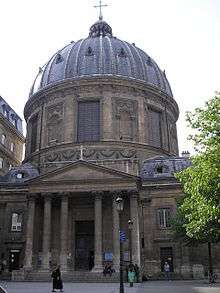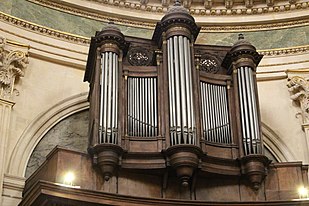Notre-Dame-de-l'Assomption, Paris
Notre-Dame-de-l'Assomption is a catholic church in Paris, France. This church was built between 1670 and 1676 (date of completion of the works and the consecration). Today, it is the main Polish church of Paris.

History
| Wikimedia Commons has media related to Église Notre-Dame-de-l'Assomption de Paris. |
In the XVII century, a house street Saint-Honoré belonging to the Jesuits was given to the "Ladies of the Assumption" ("Dames de l'Assomption") who transformed it into convent by undertaking constructions for which they called on to the architect Charles Errard.
The latter stays then in Rome and, keen on Italianism, his project is inspired by the Antiquity, by the Renaissance with, however, a personal note. His Roman obligations will prevent him from watching the execution of the building, the load of which will be assured by Mr Chéret. Further to the criticisms lifted by his construction, Charles Errard will accuse the latter of having modified his plans.
It is in the convent of the "Ladies of the Assumption" ("Dames de l'Assomption"), situated in the no 263 street Saint-Honoré that withdrew certain Court Ladies under the old regime. It was transformed into barracks during the Revolution, in 1793.
“Cavaillé-Coll” Organ[1]

The organ dates the end of the XIXth century. It was built by Aristide Cavaillé-Coll.
| 1st Manual | 2nd Manual | Pedals | |
|---|---|---|---|
| Grand Orgue (GO) ("Great Organ") | Récit Expressif (RE) (Swell) | Pédalier | Accouplements |
| Cromorne 8' | Clairon 4' | Flûte 4' | RE / GO 8' |
| Plein Jeu IV rangs | Trompette 8' | Basse 8' | RE / GO 16' |
| Doublette 2' | Tierce 1' 3/5 | Soubasse 16' | (Tirasse) RE / Pédale |
| Prestant 4' | Nasard 2' 2/3 | Quintaton 32' | (Tirasse) GO / Pédale |
| Flûte Harmonique 8' | Flageolet 2' | ||
| Bourdon 8' | Flûte 4' | ||
| Montre 8' | Cor de Nuit 8' | ||
| Bourdon 16' | RE 16' |
See also
References
- "Organ Description". MusicamSacram.pl. 12 December 2017. Retrieved 12 December 2017.